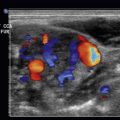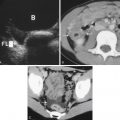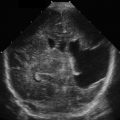Introduction
Single-injection ultrasound-guided peripheral nerve blocks (USGNBs) are ideal for pain relief from acute injuries and adjunct analgesic for painful procedures. By injecting local anesthetic adjacent to the nerve, both motor and sensory innervation distally can be “blocked.” Depending on the efficacy of the USGNB, adjunctive therapies (such as intravenous medications) can be employed to achieve maximal patient comfort. Incorporation of USGNBs into clinical practice allows for a targeted approach to treat pain effectively and reduces the known complications of repeated (or high-dose) opioids.
Emergency physicians have demonstrated the ability to effectively and safely perform USGNBs in the acute setting for multiple indications (fractures, abscess drainage, joint reduction, etc.). Ultrasound guidance may reduce time of block onset and volume of anesthetic required compared with standard nonvisualized/landmark techniques. Ultrasound visualization can also decrease the likelihood of intraneural injections and inadvertent vascular puncture.
Clinicians performing USGNBs should be aware of two uncommon complications that can occur: peripheral nerve injury (PNI) and local anesthetic systemic toxicity (LAST). PNI is defined as persistent motor or sensory deficit and/or pain after the nerve block. The incidence of PNI ranges from 0.5% to 2.4% in the current literature, and the mechanism is not clearly understood in all reported cases. Hypotheses include direct needle trauma, increased intrafascicular pressures from injection, direct cytotoxic effects of anesthetic, or metabolic stress of the anesthetic leading to nerve ischemia. Patients with underlying peripheral neuropathy are contraindicated from having a nerve block because postblock determination of PNI will be not possible.
Recommendations to minimize PNI include maintaining visualization of the needle tip to avoid direct contact with the nerve fascicle and a deliberate, low-pressure injection technique. Instruct the patient to inform the clinician of radicular pain during the procedure. If the patient reports any symptoms, the procedure should be interrupted, and the patient and needle placement reassessed. Subsequent actions are based on the clinical scenario. These safeguards cannot completely prevent PNI but may minimize the incidence.
LAST can occur with a toxic dose of anesthetic, with rapid absorption of anesthetic, or due to inadvertent intravascular injection. Patients are maintained on continuous cardiac monitoring for these procedures. If a patient develops signs or symptoms of LAST, a hyperlipophilic solution (20% Intralipid; 1–1.5-mg/kg bolus with continued infusion of 0.25 mL/kg/min) should be infused. Intralipid in 20% should be readily available when performing a nerve block.
There are two commonly used approaches to perform USGNBs: in-plane and out-of-plane. The in-plane technique, in which the transducer is aligned in the long axis of the needle, allows clear visualization of the entire needle. This technique allows confirmation of the needle tip, the nerve, and the injected anesthetic. With the out-of-plane technique, in which the transducer is aligned in the long axis of the needle, the needle will not be visualized in its entirety. In this view, the operator must ensure that the needle tip, rather than the shaft of the needle, is being visualized to prevent misplacement of the needle tip.
There are general preparation steps to be performed for all USGNBs. Single-injection USGNBs are performed with aseptic technique and do not require sterile preparation. Perform skin preparation. Then perform the ultrasound survey to locate the nerve and identify other anatomic structures of interest. Place a skin wheal of rapidly acting local anesthetic at the planned needle insertion site. Clean the ultrasound probe and cover it with a transparent, adhesive dressing or insert into a sleeve. We recommend using sterile gel for the procedure. A blunt tip can be used for nerve blocks but are not required.
Before performing an ultrasound-guided nerve block, the clinician should look up the maximal dose and volume of anesthetic based on the patient’s weight. All volumes presented in this chapter are for adult patients. Again, the clinician should not confuse the maximal dose of anesthetic with volumes (as listed in the chapter).
Before injecting the local anesthetic, the patient should be educated regarding the symptoms of local anesthetic toxicity and instructed to notify the clinician immediately if any symptoms are noted. Injecting large volumes of local anesthetic should be performed incrementally. After each injection, the clinician should pause and monitor for signs and symptoms of local anesthetic toxicity. If the patient reports any symptoms, the procedure should be interrupted, and the patient and needle placement reassessed. Subsequent actions are based on the clinical scenario.
Femoral Nerve
Indications
The femoral nerve provides innervation to the entire anterior thigh and most of the femur and knee joint, making it an ideal nerve block for hip fractures, proximal and midshaft femur fractures, large anterior thigh wound repairs, and patellar injuries. In patients with a hip fracture, a femoral nerve block gives moderate pain reduction but does not provide complete analgesia to the hip because the obturator nerve, one of the three nerves that innervate the hip, is not blocked by this approach. However, the femoral nerve block can significantly decrease the need for intravenous opioid medications, thereby reducing the risk of adverse effects, including respiratory depression, confusion, and hypotension, especially in the elderly. Although the risk of developing compartment syndrome of the thigh is very rare, we recommend the block be performed after achieving consensus with the consultative service in situations that require it.
Anatomy
The femoral nerve is one of the major branches of the lumbar plexus arising from the first through fourth lumbar ventral rami (L1–L4) before descending toward the lower extremity. The femoral nerve can be identified lateral to the femoral artery, beneath the fascia iliaca and superficial to the iliopsoas muscle at the level of the inguinal canal ( Fig. 31.1 ).

Technique
Place the patient in a supine position. Attempt to externally rotate and abduct the hip, realizing that it is often not possible in the acutely injured patient and may not be needed. Place the high-frequency linear transducer just below and parallel to the inguinal crease. Locate the femoral artery and vein in cross-section, and slowly slide the transducer laterally to identify the femoral nerve. The femoral nerve appears as a hyperechoic, triangular structure below the hyperechoic fascia iliaca and above the iliopsoas muscle (see Fig. 31.1 ). Slightly fanning the probe in a caudal direction, perpendicular to the trajectory of the nerve, will often allow for better visualization of the nerve. The operator should also locate the fascia iliaca—the fascial covering that covers the femoral nerve. Placing the anesthetic just below the hyperechoic fascia iliaca is key to obtaining an effective femoral nerve block.
Once the femoral nerve and surrounding anatomic structures are identified, a small skin wheal should be made approximately 0.5 to 1 cm lateral to the probe, which will represent the site of needle entry. Perform the preparatory steps discussed earlier. A 20-gauge, 3.5-inch (approximately 8.9 cm) block needle is inserted with direct ultrasound visualization. Advance the needle slowly at an angle parallel to the transducer using an in-plane approach, maintaining the needle shaft and tip in view at all times. The angle of entry will depend on the depth of the target depth of the fascia iliaca. More shallow angles of entry will improve needle visualization. Target the hyperechoic fascia iliaca overlying the iliopsoas muscle 1 to 3 cm lateral to the femoral nerve. Once beneath the fascia iliaca, aspirate to confirm the needle tip has not entered a vessel and then slowly inject 3 to 5 mL of local anesthetic in a dose that is appropriate for the concentration of the anesthetic and the weight of the patient. With the needle tip in view, the spread of hypoechoic fluid should be visualized hydrodissecting the potential space below the fascia iliaca and around the nerve ( Fig. 31.2 ). After confirming optimal needle tip location, proceed to inject a total of 20 mL of local anesthetic in a dose that is appropriate for the concentration of the anesthetic and the weight of the patient in 3- to 5-mL aliquots. The most common pitfall is failure to get under the fascia iliaca; therefore anesthetic should be visualized under the fascial plane with the spread of anechoic fluid. The risk of intravascular and intraneural injection can be reduced by targeting the needle tip to be 1 cm lateral to the femoral nerve and vessels, yet deep to the fascia iliaca. If at any point the spread of local anesthetic is not visualized, intravascular injection should be suspected and the procedure halted.

Distal Sciatic Nerve and Popliteal Fossa
Indications
The distal sciatic nerve innervates most of the lower extremity, making it an ideal block for fractures of the ankle, distal tibia, fibula, and injuries of the foot. A distal sciatic nerve block does not anesthetize the medial aspect of the lower leg, which is innervated by the saphenous nerve, a distal branch of the femoral nerve. Thus this block is not ideal for superficial injuries of the distal, medial leg. It should also be noted that, although this block is ideal for pain relief for tibial fractures, tibial injuries are typically high-energy and commonly associated with compartment syndrome. As the distal sciatic block may obscure clinical findings of compartment syndrome, it should be performed only after speaking in consensus with consulting services.
Anatomy
The lumbosacral plexus forms the sciatic nerve in the posterior pelvis. As the nerve tracks inferiorly through the posterior thigh, it enters the popliteal fossa bordered by the long head of the biceps femoris superolaterally and by the semimembranosus and semitendinosus tendons superomedially. At the most proximal point in the popliteal fossa, the large sciatic nerve bifurcates into a tibial nerve medially and a common peroneal nerve laterally. The sciatic nerve can be blocked at any location from the proximal, deep gluteal region to the distal, superficial popliteal fossa. The distal location is generally preferred for USGNB, given the ease with which adequate patient positioning can be obtained and anatomic landmarks can be sonographically identified ( Fig. 31.3 ).

Technique
The distal sciatic nerve block at the popliteal fossa is most easily accomplished with the patient in a prone position. This allows easy access to the popliteal fossa and facilitates needle movements in the anteroposterior plane that correlate with images on the ultrasound screen. In patients who are unable to lie prone (e.g., cervical spine immobilization), the affected extremity must be elevated and supported with mild flexion of the knee to fit the transducer between the popliteal fossa and the patient’s bed. Needle movements made under visualization of a transducer facing upward will appear reversed in the anteroposterior plane on the ultrasound screen.
When appropriate patient positioning has been achieved, use a high-frequency linear transducer to locate the popliteal artery and vein at the popliteal crease (this may be more easily done with slight flexion at the knee). The tibial nerve is commonly located superficial to the popliteal vein and appears as a hyperechoic “honeycomb.” Once the tibial nerve is optimally visualized, slowly slide the transducer proximally. At the cephalad border of the popliteal fossa, the common peroneal nerve should be visualized joining the tibial nerve, forming the distal sciatic nerve ( Fig. 31.4 ). The operator should mark this location and note the depth of the nerve.

In contrast to a femoral nerve block in which the needle is inserted adjacent to the transducer, for a distal sciatic nerve block, we recommend inserting the needle farther away from the transducer on the lateral aspect of the leg. The distal sciatic nerve is often 2 to 4 cm deep to the skin surface, and a steep needle angle from a point of entry just adjacent to the ultrasound probe would prevent clear needle tip visualization. To improve needle visualization, we recommend measuring the nerve depth and entering the lateral leg at a similar depth with a fairly flat angle (parallel to the surface of a linear probe).
After placing a skin wheal at the site of needle entry, advance a 20-gauge, 3.5-inch needle slowly at an angle parallel to the transducer using an in-plane approach. Maintain the needle shaft and tip in view at all times. Target the honeycomb appearance of the sciatic nerve without placing the needle directly into the nerve. Place the needle tip just superficial to the nerve (anywhere from 2–3 mm) to reduce the risk of nerve injury. Gently aspirate to confirm there has been no inadvertent vascular puncture and then slowly inject 3 to 5 mL of local anesthetic in a dose that is appropriate for the concentration of the anesthetic and the weight of the patient. With the needle tip in view, the spread of anechoic fluid should be visualized in real time ( Fig. 31.5 ). For novice sonographers, we do not recommend attempting to inject on the deep aspect of the nerve because of the close proximity to the popliteal vasculature and the increased possibility of inadvertent intravascular injection. If at any point the spread of local anesthetic is not visualized, intravascular injection should be suspected and the procedure halted.

Posterior Tibial Nerve
Indications
The posterior tibial nerve is a distal branch of the sciatic nerve. Blocking it above the medial malleolus in the distal leg results in excellent anesthesia for the skin of the sole of the foot and the underlying deep structures. Classic indications for this block include anesthesia for the sole of the foot (repairs, abscesses, foreign body removal), as well as an adjunct for pain during the reduction of calcaneal fractures. The ankle joint itself has multiple innervations and will not be blocked with a posterior tibial block alone.
Anatomy
The posterior tibial nerve runs parallel to the posterior tibial artery, which branches from the popliteal artery at the popliteal fossa and runs down the length of the posteromedial tibia. At the level of the ankle, the posterior tibial artery travels posteriorly and inferiorly around the medial malleolus. The posterior tibial nerve, in turn, travels posterior and inferior to the artery ( Fig. 31.6 ).

Technique
Position the patient with the ipsilateral hip externally rotated and flexed at the knee so that the medial malleolus is well exposed. If this position cannot be tolerated, the patient can be positioned in a lateral decubitus position with the medial side of the foot and ankle exposed. Identify the medial malleolus and posterior tibial artery by inspection and palpation.
Holding the linear probe in a position perpendicular to the orientation of the tibial artery, slide up the leg from the ankle and watch for separation of the posterior tibial artery and posterior tibial nerve. Classically, you should see the nerve posterior to the vascular bundle, but there is a great deal of anatomic variation ( Fig. 31.7A ).

If an out-of-plane approach is used, whether as a result of patient positioning or provider preference, we recommend inserting a 21- to 25-gauge needle in the middle of the probe at a steep angle. Aim posterior to the posterior tibial nerve bundle and maintain visualization of the needle tip. After puncturing the fascial plane superficial to both the vascular bundle and posterior tibial nerve, inject a small aliquot of normal saline or local anesthetic to confirm appropriate placement.
For the in-plane approach to the posterior tibial nerve, insert a 21- to 25-gauge needle posterior to the linear probe. This approach will give better visualization when entering the fascial plane that contains the posterior tibial nerve and vascular bundle. Entering posteriorly provides a lower risk of puncturing the anterior vascular structures ( Fig. 31.7B ).
Brachial Plexus: Interscalene Nerve Block
Indications
The interscalene brachial plexus block results in anesthesia to the shoulder and upper arm. The interscalene brachial plexus block has multiple applications, including pain control of proximal upper extremity fractures, large deltoid abscess drainage, pain control and debridement of burns, deep wound exploration, complex laceration repairs, and as an alternative method to procedural sedation for the reduction of shoulder dislocations. Of note, the interscalene block does not reliably provide anesthesia distal to the elbow.
The interscalene nerve block is associated with a risk of transient hemidiaphragmatic paresis due to the close proximity of the phrenic nerve. The use of ultrasound guidance has decreased the rate of diaphragmatic paresis due to the lower volume of anesthetic and increased precision of anesthetic delivery. Although the clinical significance of transient paralysis in unilateral phrenic nerve distribution is debated, caution is recommended when considering an interscalene block in patients with poor pulmonary reserve.
Anatomy
The interscalene nerve block targets the brachial plexus at the level of the roots as they pass through the interscalene groove, lateral to the carotid artery, between the anterior and middle scalene muscles. The interscalene groove is bordered medially by the anterior scalene muscle and laterally by the middle scalene muscle at the level of the cricoid cartilage and below the clavicular head of the sternocleidomastoid muscle ( Fig. 31.8 ). The C5–T1 nerve roots are positioned vertically within the interscalene groove, starting with C5, the most superficial root. Anesthetic placed in this fascial plane commonly does not track around the inferiorly located C8–T1 nerve roots and therefore does not reliably provide anesthesia for injuries distal to the elbow. The carotid artery and internal jugular vein lie medial to the anterior scalene muscle. The dome of the pleura is located caudally. Risk of iatrogenic pneumothorax due to pleural puncture is low with ultrasound-guided needle visualization.











